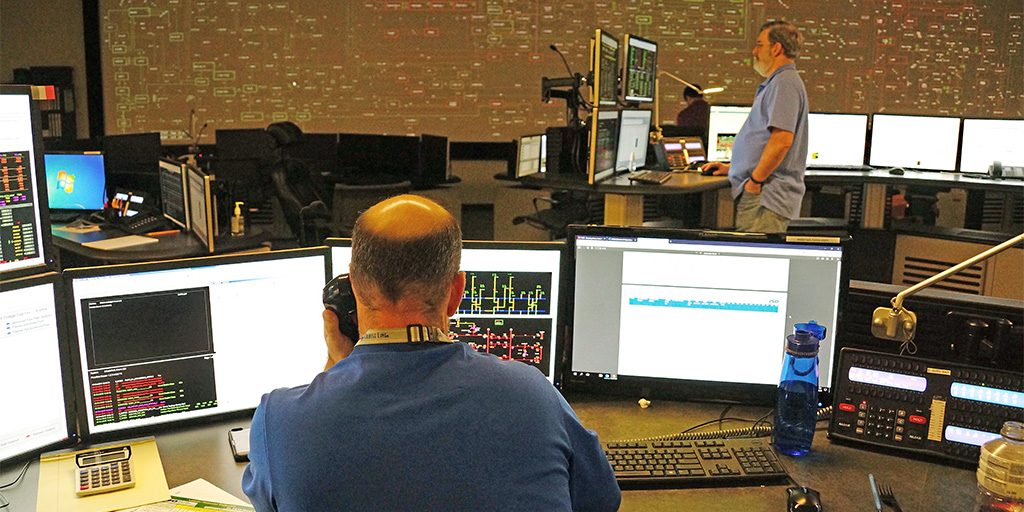Conductors of the Electric Orchestra: How NYISO Operators Learn to Keep the Power Flowing

Every minute of every day, the electricity consumed in New York State is controlled by seven people sitting in a room at the headquarters of the New York Independent System Operator. Inside this control room, operators keep track of every major power line across the state, reacting to the ever-changing demands of the electric grid.
How do these NYISO employees get so good at what they do? By practicing how to manage the grid when things go wrong on a “blue-sky” day. And for this, they use the NYISO’s simulator room.
The simulator allows operators to prepare for scenarios such as a sudden generator shut-off or a fault in a transmission line. It’s a smaller version of the control room, but otherwise an exact copy, allowing participants to run through various scenarios under the watchful eyes of expert trainers.
“It helps them prepare for situations so they can react properly,” says Robert Brown, supervisor of System Operator Training at the NYISO. “It’s about giving the operator the experience, preferably before they see it on the control room floor.”

PHOTO: Kenneth Lizke, shift supervisor of the Control Room, looks at multiple screens of information during a recent day at NYISO's Control Room Simultor.
On a recent afternoon, a team of control room operators led by Kenneth Litzke, a NYISO shift supervisor, spent several hours running through various simulations. Operators do everything from electric load forecasting to monitoring transmission. They sit (or stand, in Litzke’s case) at long, curving desks, continually monitoring up to nine computer screens the way airplane pilots scan dials and readouts.
Operators rotate between day and night schedules, ensuring 24 hour operations of the control room. Operators also must be certified annually by the North American Electric Reliability Corp. (NERC), a regulatory authority dedicated to grid reliability and security. As such, they need yearly training to earn required education hours—including time in the simulator.
Running the grid, in theory, follows a simple formula — the amount of power generated has to equal the amount of power being consumed (although the growing use of energy storage helps to cushion that equation). As this is being managed, power flows in and out of New York as well, as the NYISO works in tandem with controllers in neighboring states. If the grid is an electrical orchestra, the operators are conductors, constantly giving directions to its many musicians — generators, utilities and transmission owners.
This afternoon’s simulation begins with the operators going about their normal duties: monitoring power output, looking at how the power is being sold in the NYISO-administered wholesale markets, predicting how load requirements might rise over the course of the day. At about 1 p.m., they get their first curveball in this mock-scenario —a section of transmission line in the Hudson Valley trips, meaning it can no longer carry power. Operators then need to maintain power flows on the remaining lines within transmission limits, and may make adjustments to system configuration.

PHOTO: Operator Jeff Mullen phones a (mock) utility operator to recalibrate power generation during a simulation of a line loss.
The team is being watched by a half-dozen trainers, who control the simulation. Soundproof glass separates them from the operators. They listen, via microphones, to everything that is said on the floor. “We’re live— game on,” says one trainer.
On the simulator floor, an alarm goes off— actually a chime that can be heard throughout the room. Operators look to their alarm screens to see what the problem is. Much of this particular simulation will fall to an operator named Jeff Mullen, whose desk is responsible for the region affected by the out-of-service line.
“When alarms come in there is a couple of things that go through my mind, the first being to identify the sound,” says Mullen, who has been an operator at NYISO for 12 years. “Different sounds have different meanings and can help direct attention to the right place. The next thing I do is confirm that what is alarming actually happened.”
Watching how Mullen and other operators react to the problem (known in the business as a “contingency”) illustrates the continued cooperation among NYISO, the various generators and utilities around the state, and the operators of neighboring state grids. During the simulation, Mullen calls local utilities (actually a trainer inside the glass both) to discuss the shift in power and how to handle it.

PHOTO: Mullen discusses a mock line outage with a trainer in the simulator.
“After you determine what happened, you start to prioritize your response,” Mullen says. “You deal with any actual overloads first, then start to reduce post-contingency loadings for the next contingency. Essentially you fix each problem with attention towards the worst one first.”
NYISO cannot physically start or stop power generation, or change the flow of power along the grid. So operators must keep in constant touch with utilities and generators. Communication skills are nearly as important to an operator as technical knowledge.
Had this scenario been real, few people outside the control room would have even been aware that this blip even existed. Which, of course, is the job of the operators.
“Time and experience are what help to understand what you react to and to what degree,” Mullen says. “You learn what the solutions are for different problems that arise, and build kind of a mental Rolodex of what to do in the event of a loss or contingency.”
The simulation goes on, with more scenarios created. Amid the operators, someone calmly whistles, “And the Caissons go rolling along.” It’s just another day running New York’s power grid.
At the end of the simulation, the operators gather round to be debriefed by the trainers. They performed admirably. “You guys are paying attention,” one trainer tells them. “You’re on top.”

